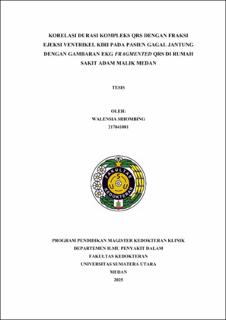| dc.description.abstract | Introduction. Heart failure is a clinical syndrome caused by ventricular dysfunction or
structural abnormalities, affecting 1–3% of adults globally, with higher prevalence in
those over 65. In Asia, there are around 721,100 cases, with 5% in Indonesia. Based on
LVEF, it is classified into HFrEF, HFmrEF, and HFpEF. Fragmented QRS (fQRS) on
ECG indicates myocardial damage and reduced LVEF. Indonesian studies highlight
fQRS in assessing myocardial injury and heart failure severity. This study analyzed the
relationship between QRS duration and LVEF in patients with heart failure at Adam
Malik Hospital Medan.
Method. A cross-sectional study was conducted at Adam Malik Hospital Medan from
January-December 2023. Participants were selected through consecutive sampling,
meeting inclusion criteria of acute heart failure diagnosis and documented LVEF, while
those with pacemakers, defibrillators, or acute myocardial infarction were excluded. Data
were analyzed using SPSS 26, with Spearman test for correlation of QRS duration and
LVEF. A Cardiovascular Consultant evaluated the fQRS data for accuracy.
Result. Heart failure patients at Adam Malik General Hospital had a mean age of 53,25 ±
12,02 years, with 60,5% male. fQRS duration ranged from 80–180 ms in the fQRS (+)
group and 78–110 ms in the fQRS (-) group. LVEF <50% was found in 55,6% of
patients, while 44,4% had LVEF ≥50%. A weak negative association existed between
QRS duration and LVEF (r = -0,255, p = 0,021).
Conclusion: The QRS complex duration was found higher in group with fQRS (+)
compared to fQRS (-). A weak negative correlation was found between QRS duration and
LVEF. | en_US |


